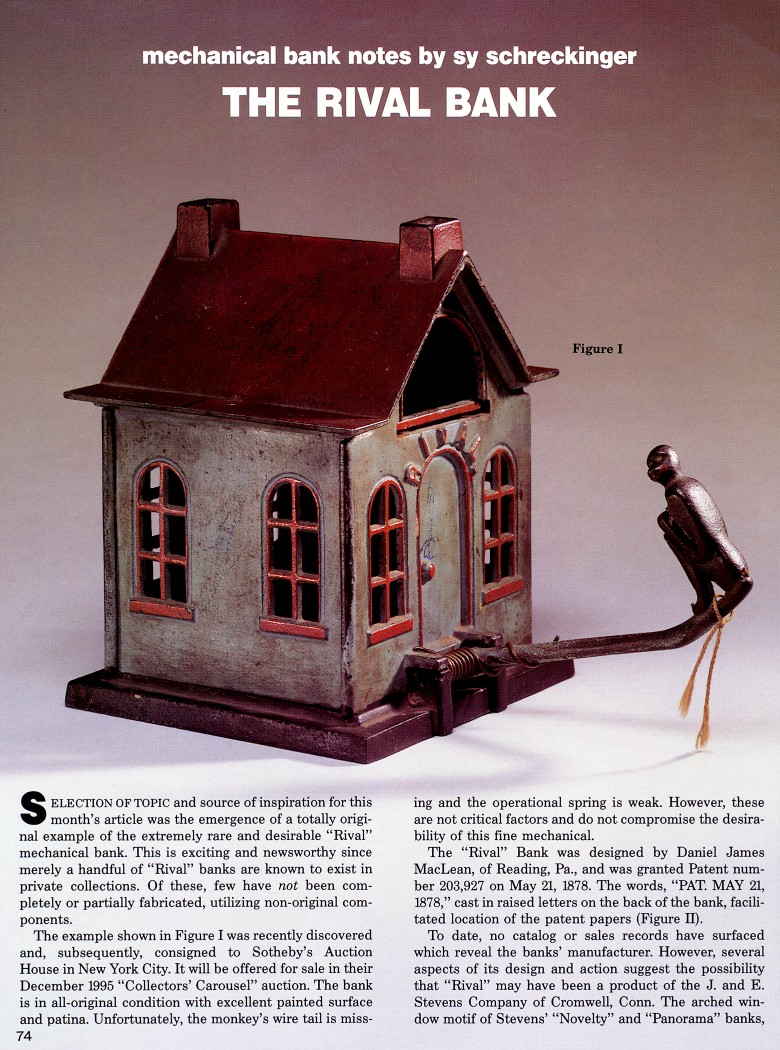|
The Rival Bank
by Sy Schreckinger – ANTIQUE TOY WORLD Magazine – December,
1995
Selection of topic and source of inspiration
for this month's article was the emergence of a totally original example
of the extremely rare and desirable "Rival" mechanical bank. This is
exciting and newsworthy since merely a handful of "Rival" banks are known
to exist in private collections. Of these, few have not been completely or
partially fabricated, utilizing non-original components.
The example shown in Figure I was recently discovered and,
subsequently, consigned to Sotheby's Auction House in New York City. It
will be offered for sale in their December 1995 "Collectors' Carousel"
auction. The bank is in all-original condition with excellent painted
surface and patina. Unfortunately, the monkey's wire tail is missing and
the operational spring is weak. However, these are not critical factors
and do not compromise the desirability of this fine mechanical.
The "Rival" Bank was designed by Daniel James MacLean, of Reading,
Pa., and was granted Patent number
203,927 on May 21, 1878. The words,
"PAT. MAY 21, 1878," cast in raised letters on the back of the bank,
facilitated location of the patent papers (Figure II).
To date, no catalog or sales records have surfaced which reveal the
banks' manufacturer. However, several aspects of its design and action
suggest the possibility that "Rival" may have been a product of the J. and
E. Stevens Company of Cromwell, Conn. The arched window motif of Stevens'
"Novelty" and "Panorama" banks, combined with the action of their "Mule
Entering Barn" Bank (Antique Toy World,
June 1987) seem quite reminiscent
of the design of the arched windows and action of the "Rival."
Notwithstanding, the actual manufacturer of "Rival" Bank adhered
closely to Mr. MacLean's patent drawings, the only difference being the
operational spring design. The patent, Figure II, indicates an internal
spring mechanism, whereas the bank itself (Figure I) utilizes an external
spring attached to the extend fulcrum connected to the monkey.
Action of the "Rival" is incomplex: the monkey is pressed downward
and held in a horizontal position. A coin is then inserted within the slot
between its chest and knees. Upon release, the monkey springs forward,
depositing the coin into the large, arched dormer window. An internal
baffle prevents the coins from being shaken out. Deposits are removed by
unscrewing the two threaded nuts underneath the base plate.
To the best of my knowledge, there are a few color, but no casting
variations of the "Rival" Bank. One original example has brown walls and a
red roof. The bank shown in Figure I is painted a light aquamarine blue,
with a red roof and red trim around the door and windows. The base is dark
brown and the monkey is brown with light blue eyes and a red mouth.
Webster's Dictionary defines "rival" as "a person or thing that can
reasonably be said to equal or surpass another in some way." Based upon
Webster's definition and particular statements in the patent papers, one
might gain some insight as to why Mr. MacLean named his creation "Rival."
The papers read, "the advantages of my toy bank are, first, that it holds
more money than any other bank of the same size; secondly, that any size
coin, from a cent to a trade-dollar, may be deposited with equal facility;
and, lastly, that the working of the figure will cause great amusement to
the children."
Unfortunately, several reproductions of the "Rival" Bank have been
created. Ergo, Figure III: a base diagram of the original example shown in
Figure I. Recasts will appear approximately one-eighth to one-quarter of
an inch shorter, O.D. along the base than indicated.
Inquiries regarding the December 1995 Sotheby's Auction sale in which
the "Rival" Bank (Figure I) will be offered, should be directed to Ms.
Dana Hawkes or Ms. Alison Kurke, Sotheby's New York.
Acknowledgement: My thanks to bank collectors Frank Kidd and Steve
Steckbeck who shared information pertinent to the writing of this article.
|


